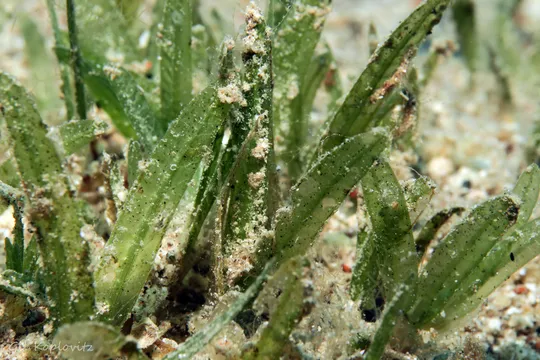Spoon Seagrass, Paddle Grass
Halophila ovalis
Halophila ovalis
was collected a single time on the coast of Elat by Ya'acov Lipkin in 1963. According to evidence from recent years, it does not grow
today in the Israeli coastal region of the Gulf of Elat, and is probably
extinct (Yaacov Lipkin, Jacob Dafni, Dudu Zakay, pers.
comm.). H. ovalis
grows on the coast of eastern Sinai along the Gulf of Elat, and in the Gulf of
Suez.
In seawater, usually from the lower end of intertidal
zone to a depth of 2 m. In the Gulf of Elat H.
ovalis is part of a community that creates sparse cover.
Sometimes stands of H. ovalis
appear in other plant communities, such as the H. stipulacea
community.
The genus Halophila numbers nine
species, all submersed sea grasses found close to the coasts of the tropical regions
of the world. In the Red Sea, there are three species, two of which grow in the
Gulf of Elat: H.stipulacea and H.
ovalis. The genus belongs to the Hydrocharitaceae family,
all of whose plants are submersed in both salt and fresh water. Other species
in this family that once grew in freshwater wetlands in Israel and became
extinct when the Hula Marsh was drained are Vallisneria spiralis and
Hydrocharis morsus-ranae.
·
The
Halophila
ovalis population has become
extinct from the only site in which it was found in the 1960s.
·
H. ovalis is a found on the tropical beaches of the Indian Ocean and the
Red Sea and is not globally endangered.
Efforts should be made to reintroduce Halophila
ovalisfrom the Sinai coast in the Gulf of Elat to the site
where it was once found.
Halophila ovalis
is broadly distributed in the tropical seas connected to the Indian Ocean. It
is found in the Red Sea, on the coasts of East Africa and the Indian Ocean and
eastward to the shores of Malaysia and Indonesia. In the Middle East, it grows
in the Gulf of Elat and in the Gulf of Suez, on the Red Sea coast of Egypt,
Arabia and Southern Iran.
Halophila
ovalis is a sea grass of tropical seas, which was very rare
on the shores of the Gulf of Elat in Israel, and which is now extinct. This
extinction is part of the general decline in the flora and fauna of the Gulf of
Elat coast as a result of development, construction and water pollution.
ויזל, י. וליפשיץ, נ. 1972. צמחי מים בישראל. רשות שמורות הטבע
ליפקין, י. 1987. עשבי הים בחופי סיני. בתוך: גבירצמן, ג., שמואלי, א. גרדוס, י. ובית אריה, י. (עורכים): סיני – כרך א', גיאוגרפיה פיזית. משרד הבטחון – ההוצאה לאור. 495-504.
Lipkin, Y., Beer, S. and Zakay, D. 2003. The seagrasses of the eastern editerranean and the Red Sea. In: E. Green and F.T Short (eds.). World Atlas of Seagrasses. University of California Press, pp. 75-83.
Current Occupancy Map
| 1000 squre meter pixel | 5000 squre meter pixel | 10000 squre meter pixel | |
|---|---|---|---|
| number of observations | 0 | 0 | 0 |
| in total pixels | 0 | 0 | 0 |
| Family | Hydrocharitaceae |
| Classification | On the endangered species list |
| Ecosystem | Red Sea |
| Chorotype | Tropical and Sub-tropical |
| Conservation Site |
| Rarity |
1
6
6
|
|---|---|
| Vulnerability |
0
4
4
|
| Attractiveness |
0
0
4
|
| Endemism |
0
0
4
|
| Red number |
1
-1.0
10
|
| Peripherality | S |
| IUCN category | DD EW EX LC CR EN VU NT |
| Threat Definition according to the red book | Extinct |
 Based on:
Based on:






